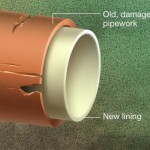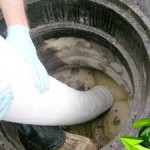 A cured-in-place pipe (CIPP) is the newest trend in trenchless pipe rehabilitation methods used to repair and repalce existing pipe lines. CIPP is a jointless, seamless, no-dig, pipe-within-a-pipe that can replace anywhere from 4 feet of pipe to 100 feet. A widely used rehabilitation method, CIPP, can be used for water, sewer, gas, and chemical pipelines.
A cured-in-place pipe (CIPP) is the newest trend in trenchless pipe rehabilitation methods used to repair and repalce existing pipe lines. CIPP is a jointless, seamless, no-dig, pipe-within-a-pipe that can replace anywhere from 4 feet of pipe to 100 feet. A widely used rehabilitation method, CIPP, can be used for water, sewer, gas, and chemical pipelines.
The CIPP Process
This is not your ordinary “dig and replace” pipe repair. The liner is inverted using water or air pressure. The inversion pressure is generated using a pressure controlling manifold. Hot water, UV light, or room temperature can cure the pipe.
 A resin-saturated felt tube made of polyester is inverted into a damaged pipe either from the upstream or downstream access point (manhole or excavation). It is then pressurized and shot into the pipe or sewer continuously until the end can be verified either with a camera or visual confirmation that the liner has been completely inserted into the host. This takes the costs and destruction associated when digging is involved out of the equation, making for a more environmentally friendly and cost- effective method than traditional pipe repair. We then apply pressure to the resin and form a tight-fitting, jointless and corrosion-resistant replacement pipe. Service laterals and cut-outs are restored internally with our robotically controlled cutting devices. The rehabilitated pipe is then inspected with our closed-circuit television (CCTV). CIPP is considered a trenchless technology.
A resin-saturated felt tube made of polyester is inverted into a damaged pipe either from the upstream or downstream access point (manhole or excavation). It is then pressurized and shot into the pipe or sewer continuously until the end can be verified either with a camera or visual confirmation that the liner has been completely inserted into the host. This takes the costs and destruction associated when digging is involved out of the equation, making for a more environmentally friendly and cost- effective method than traditional pipe repair. We then apply pressure to the resin and form a tight-fitting, jointless and corrosion-resistant replacement pipe. Service laterals and cut-outs are restored internally with our robotically controlled cutting devices. The rehabilitated pipe is then inspected with our closed-circuit television (CCTV). CIPP is considered a trenchless technology.
Benefits
The trenchless technology or CIPP process at Dynamic Drain requires little to no excavation to rehabilitate a pipeline that is leaking or damaged. Excavation may be made, but usually the liner is installed through a manhole or other existing access point. In the case of sewer lines, lateral connections can be restored without excavation using a remote controlled robot that drills a hole at the point of the connection. Pipe lines larger than 24″ can sometimes have laterals reinstated by hand. The CIPP process also has a smooth interior and no joints. CIPP can repair a pipe with bends although specifications and calculations must be made to prevent wrinkling and stretching. CIPP can effective “no-dig“‘ solution that can reduce infiltration and leaks in any pipeline system without costly destruction to your property.
Limits and Disclsoures
CIPP usually requires bypass of the flow in the existing pipeline. The curing can take anywhere from five hours to 30 hours depending on the conditions. They must be carefully monitored, inspected, and tested to ensure proper curing of the epoxies. Cost should be compared with similar methods such as Shotcrete, thermoformed pipe, close-fit pipe, spiral wound pipe and sliplining as these other methods may provide similar solutions for similar or less cost in certain situations. CIPP must be monitored for release of chemical agents used in the resin and epoxies. The liner materials we use are normally a felted fabric (weave). Liners used for pipes with bends are made from a woven fabric allowing it to go around bends with minimal wrinkling. This means extra care must be taken to ensure the liner remains perfectly fitted and adheres correctly.
